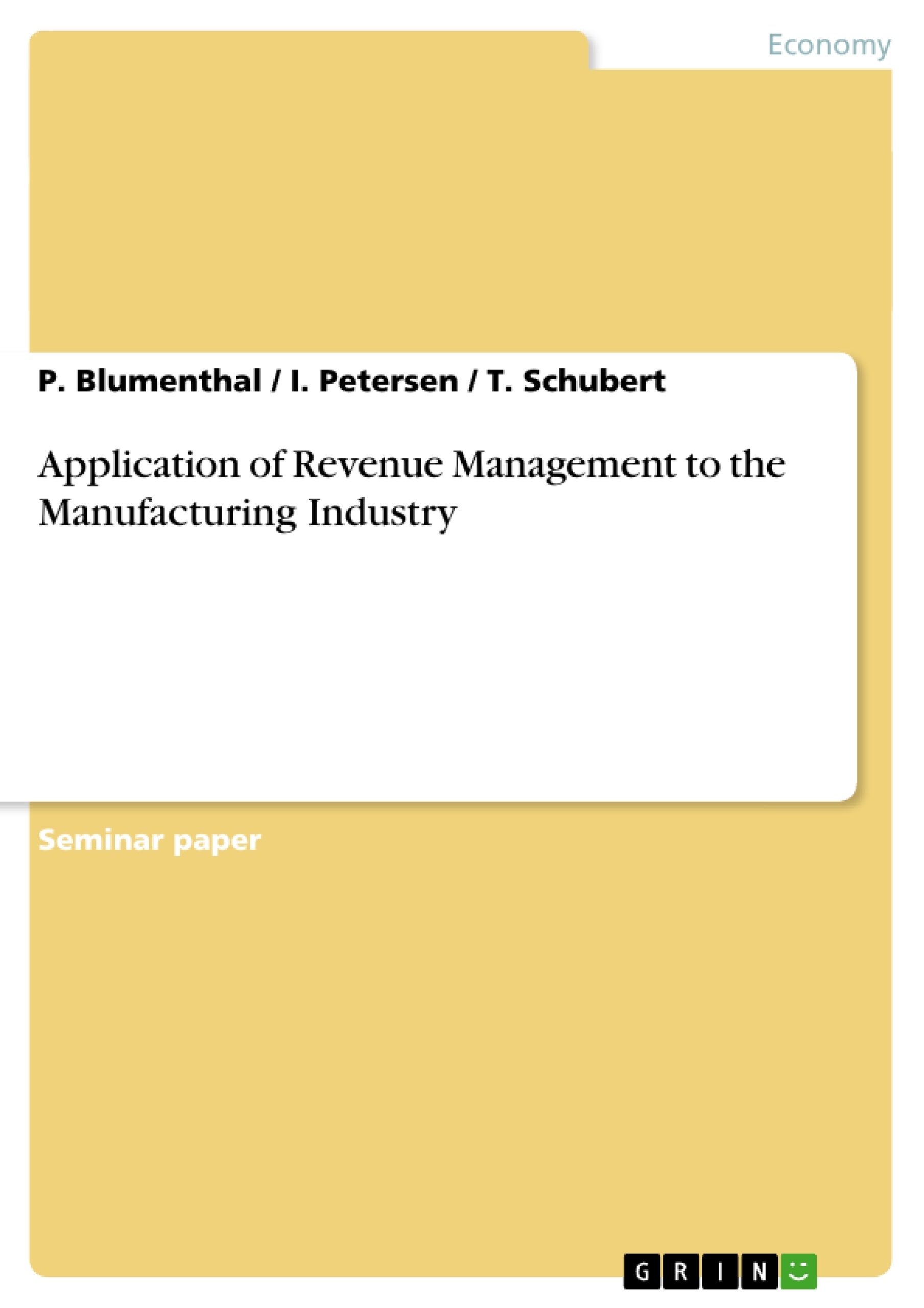Revenue management (RM) is the umbrella term for a set of strategies, tactics and
instruments aiming at the maximization of yield by allocating a company’s capacity to
different customers at different prices. Due to its great success, the application of
revenue management is widespread nowadays. But as the origin of RM lies in the
airline industry, this is still the sector of its main application. Service industries such
as hotels, car-rentals or internet service providers which share the same characteristics
as the airline industry (e.g. fixed capacity and a highly uncertain demand) discovered
quite early the potential of RM. Consequently, they were the first to adopt
RM strategies.1 Retailers, broadcasting industries and companies of the energy sector
have followed lately.
The core concept of RM becomes clear, considering the economics of RM (Cross
1997, p.73ff): The downward-sloping demand curve (figure 1) shows the number of
units of a certain product which are sold at a certain price. [...]
Inhaltsverzeichnis (Table of Contents)
- Introduction
- Problem statement
- Objective
- Basics of Revenue Management
- Definition and Historical Background
- Price- vs. Quantity-based Revenue Management
- Instruments
- Forecasting
- Measuring RM performance
- Requirements for quantity-based RM
- Market
- Company
- Application to the Manufacturing Industry
- Definition of manufacturing
- Applicability in Service Industries vs. Manufacturing Industries
- Market
- Company
- Differences between the service industry and manufacturing
- In-depth look at MTO and ATO
- Implications for the use of RM methods
- Static models for bid-price generation
- Self-adjusting bid-price
- Current use of RM in manufacturing industries
- Case Study
- Setting of the case study
- RM-fitness
- Introduction of the Test Case
- Implementation
- Conclusion
- Future Trends and Challenges
- References
Zielsetzung und Themenschwerpunkte (Objectives and Key Themes)
This text aims to explore the application of Revenue Management (RM) principles to the manufacturing industry. It examines the feasibility and potential benefits of implementing RM strategies in a manufacturing context, considering the unique characteristics and challenges of this sector. The text delves into the specific requirements for quantity-based RM in manufacturing, analyzing the differences between service industries and manufacturing in terms of market dynamics, company structure, and operational processes.
- The applicability of RM in manufacturing industries
- The differences between service industries and manufacturing in terms of RM implementation
- The use of MTO and ATO production strategies in RM for manufacturing
- The development and application of static and self-adjusting bid-price models for manufacturing
- The current state of RM adoption in manufacturing industries
Zusammenfassung der Kapitel (Chapter Summaries)
The introduction sets the stage by outlining the problem statement and the objective of the text. It highlights the need to investigate the applicability of RM principles in the manufacturing industry, considering the unique characteristics and challenges of this sector.
Chapter 2 provides a comprehensive overview of the fundamentals of Revenue Management. It defines RM, traces its historical development, and distinguishes between price-based and quantity-based RM approaches. The chapter also explores various RM instruments, including forecasting techniques and performance measurement methods.
Chapter 3 delves into the specific requirements for quantity-based RM, focusing on the market and company perspectives. It examines the characteristics of markets suitable for quantity-based RM and the organizational structures and capabilities that companies need to effectively implement such strategies.
Chapter 4 explores the application of RM to the manufacturing industry. It defines manufacturing, analyzes the differences between service industries and manufacturing in terms of RM applicability, and examines the implications of MTO and ATO production strategies for RM implementation. The chapter also discusses static and self-adjusting bid-price models for manufacturing and provides insights into the current use of RM in manufacturing industries.
Chapter 5 presents a case study that demonstrates the practical application of RM principles in a manufacturing setting. It outlines the setting of the case study, assesses the RM-fitness of the company, introduces the test case, and describes the implementation process.
Schlüsselwörter (Keywords)
The keywords and focus themes of the text include Revenue Management, Manufacturing Industry, Quantity-based RM, MTO (Make-to-Order), ATO (Assemble-to-Order), Bid-Price Models, Case Study, and Implementation.
- Quote paper
- P. Blumenthal (Author), I. Petersen (Author), T. Schubert (Author), 2008, Application of Revenue Management to the Manufacturing Industry, Munich, GRIN Verlag, https://www.grin.com/document/126374
-

-

-

-
Upload your own papers! Earn money and win an iPhone X. -

-
Upload your own papers! Earn money and win an iPhone X. -

-
Upload your own papers! Earn money and win an iPhone X. -

-
Upload your own papers! Earn money and win an iPhone X. -

-
Upload your own papers! Earn money and win an iPhone X. -

-
Upload your own papers! Earn money and win an iPhone X. -

-
Upload your own papers! Earn money and win an iPhone X. -

-
Upload your own papers! Earn money and win an iPhone X. -

-
Upload your own papers! Earn money and win an iPhone X. -

-
Upload your own papers! Earn money and win an iPhone X. -

-
Upload your own papers! Earn money and win an iPhone X. -

-
Upload your own papers! Earn money and win an iPhone X.

